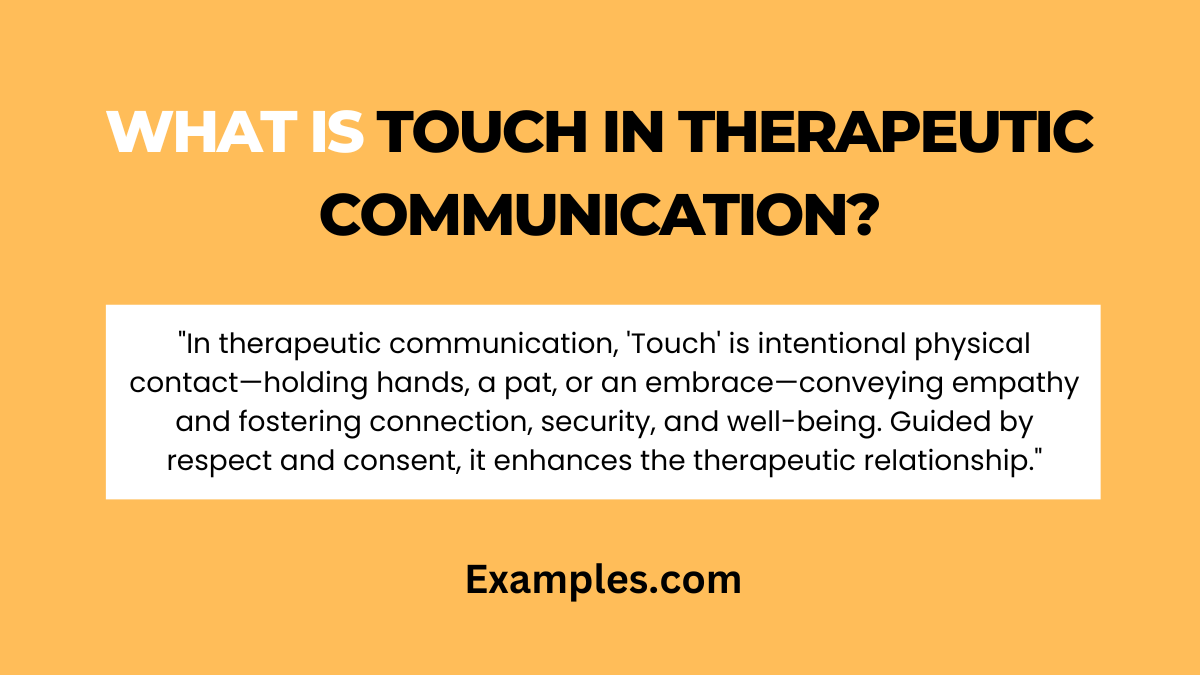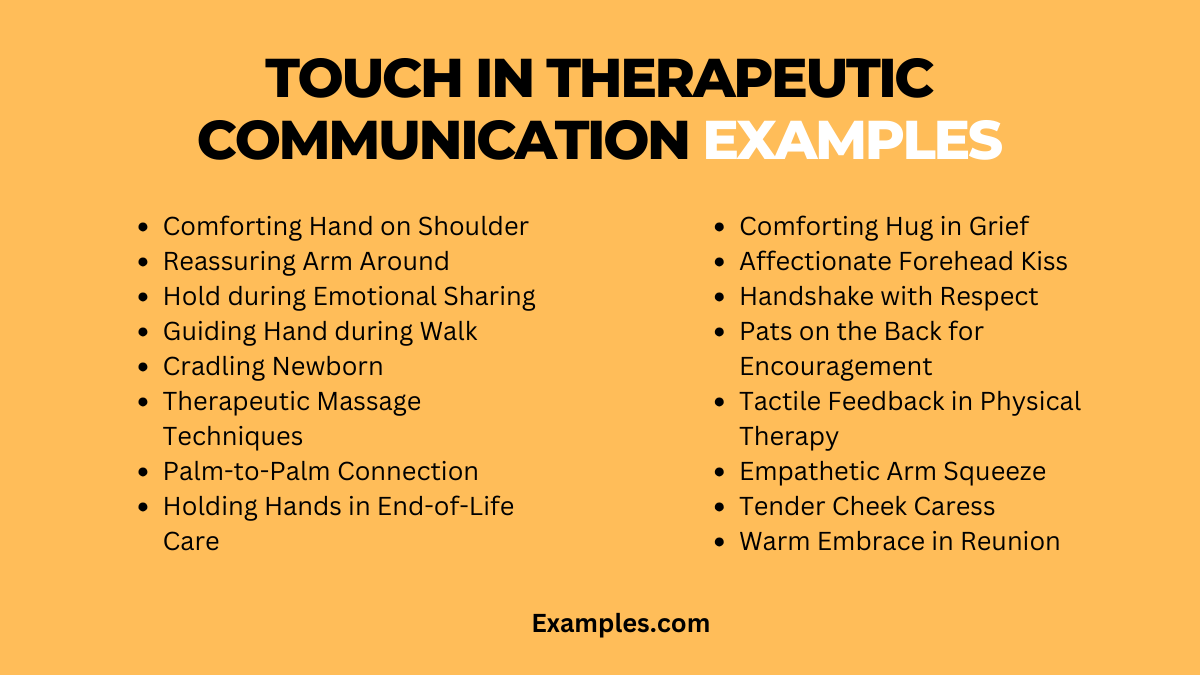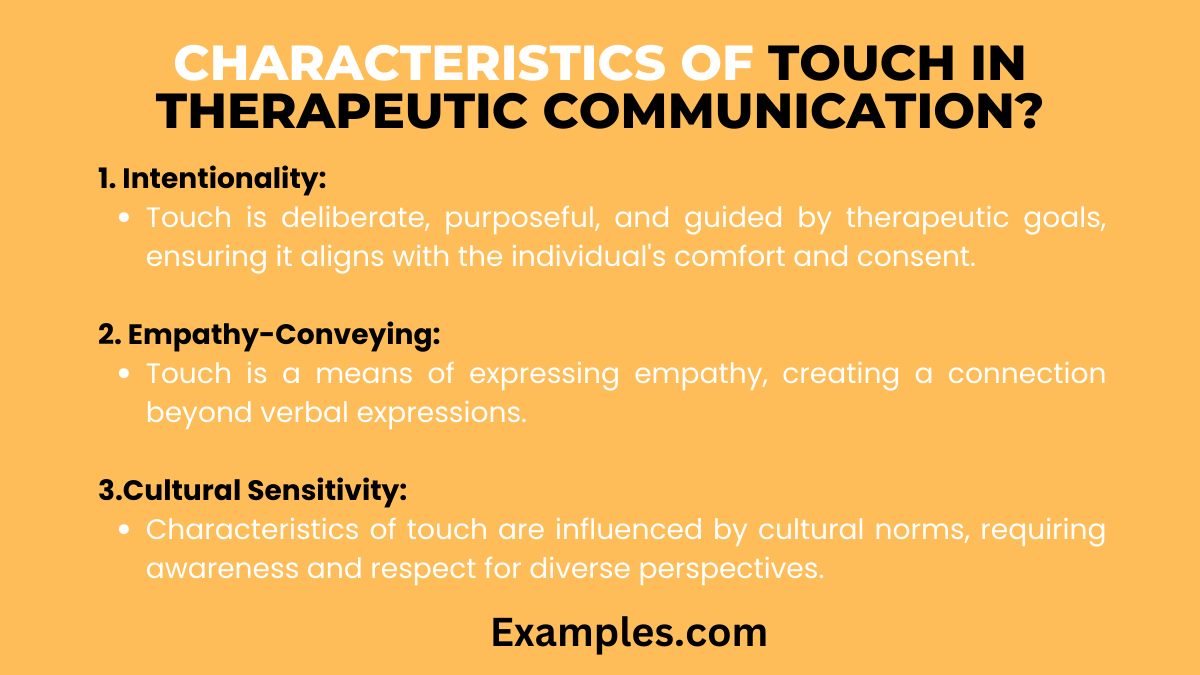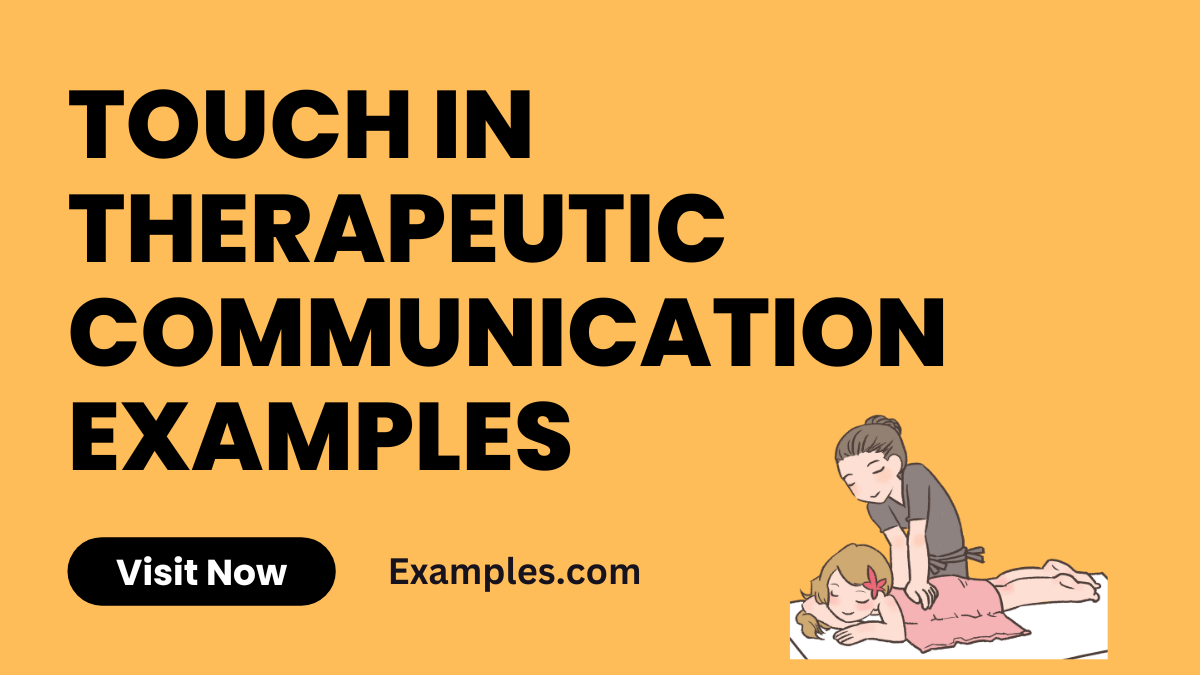Touch in Therapeutic Communication – Examples
Embark on a transformative journey exploring the significance of touch in therapeutic communication. Our guide delves into the art of using touch to convey empathy, comfort, and healing. Uncover effective techniques, tips, and enrich your practice with real-life Communication Examples, fostering a deeper connection in the realm of healthcare and well-being. Discover the profound impact of touch as a powerful tool for meaningful and compassionate communication.
What is Touch in Therapeutic Communication?

In therapeutic communication, “Touch” refers to the intentional use of physical contact to convey empathy, comfort, or support. It involves non-verbal expressions like holding hands, a comforting pat, or a gentle embrace to enhance the therapeutic relationship. This tactile approach aims to foster a deeper connection, promote a sense of security, and contribute to the overall well-being of individuals under care. The use of touch is guided by respect, consent, and the specific needs of the therapeutic context.
What is the Best Example of Touch in Therapeutic Communication?
In a healthcare setting, a poignant example of Touch involves a nurse gently holding the hand of a patient undergoing a challenging procedure. With empathy, the nurse communicates reassurance, conveying a sense of comfort and support. This tactile connection transcends words, easing the patient’s anxiety and fostering a deeper trust in the therapeutic relationship. The intentional, respectful use of touch in this context exemplifies its power to provide emotional solace and enhance the overall healing experience.
20 Touch in Therapeutic Communication Examples

Explore these impactful examples showcasing the art of touch in therapeutic communication. Each scenario is crafted to enhance understanding and proficiency in using touch to convey empathy, comfort, and support.
- Comforting Hand on Shoulder: Gently placing a hand on a patient’s shoulder to offer comfort during moments of distress or vulnerability.
- Reassuring Arm Around: Providing reassurance by placing an arm around a patient’s shoulders, creating a sense of support and understanding.
- Hold during Emotional Sharing: Holding a patient’s hand while they share emotionally charged experiences, fostering a deeper connection.
- Guiding Hand during Walk: Placing a guiding hand on a patient’s back during a walk, promoting a sense of stability and encouragement.
- Cradling Newborn: Gently cradling a newborn to promote bonding and convey a sense of security and warmth.
- Therapeutic Massage Techniques: Applying therapeutic massage techniques to alleviate tension, promoting relaxation and comfort.
- Palm-to-Palm Connection: Creating a palm-to-palm connection during conversations, enhancing non-verbal communication and understanding.
- Holding Hands in End-of-Life Care: Holding hands with a patient in end-of-life care, offering companionship and comfort in their final moments.
- Comforting Hug in Grief: Offering a comforting hug to individuals experiencing grief, providing solace and emotional support.
- Affectionate Forehead Kiss: Gently kissing a patient’s forehead as a gesture of affection and reassurance.
- Handshake with Respect: Extending a handshake with respect during introductions, establishing a professional and caring connection.
- Pats on the Back for Encouragement: Patting a patient on the back to offer encouragement and celebrate achievements in their healing journey.
- Tactile Feedback in Physical Therapy: Providing tactile feedback during physical therapy sessions, enhancing communication and adjusting techniques.
- Empathetic Arm Squeeze: Squeezing a patient’s arm with empathy, conveying understanding and emotional support.
- Tender Cheek Caress: Gently caressing a patient’s cheek to express tenderness and compassion.
- Supportive Holding of Hand: Holding a patient’s hand supportively during medical procedures, minimizing anxiety and promoting trust.
- Gentle Back Rub for Relaxation: Administering a gentle back rub to promote relaxation and alleviate stress in therapeutic settings.
- Warm Embrace in Reunion: Offering a warm embrace to patients upon reunion, expressing joy and a continued therapeutic connection.
- Thumb Rub for Calming: Rubbing a patient’s thumb gently for calming purposes, providing a soothing and comforting touch.
- Partnering in Breathing Exercises: Physically partnering with a patient in breathing exercises, synchronizing touch with therapeutic techniques for optimal outcomes.
Touch in Therapeutic Communication for Adults Examples
Explore nuanced examples illustrating the effective use of touch in therapeutic communication for adults. From conveying empathy to fostering a sense of security, these instances showcase the positive impact of tactile expressions.
- Gentle Arm Squeeze in Empathy: During emotional discussions, offer support by gently squeezing the individual’s arm, expressing empathy and connection.
- Hand-Holding for Comfort: Engage in hand-holding to provide comfort, establishing a reassuring and supportive connection during challenging moments.
- Fist Bump for Positive Reinforcement: Use a fist bump to positively reinforce achievements, creating a lighthearted yet affirming connection.
- Palm Press for Encouragement: Press palms together as a gesture of encouragement, fostering a motivational and empowering atmosphere.
- Back Pat during Stressful Situations: Pat the individual’s back during stressful situations, conveying support and reducing tension.
- Forehead Touch for Empathetic Connection: In moments of vulnerability, gently touch foreheads to establish an empathetic connection and convey understanding.
- Shoulder Squeeze for Reassurance: Offer reassurance by squeezing the shoulders, providing a comforting touch during moments of uncertainty.
- High-Five for Celebrating Success: Celebrate achievements with a high-five, promoting a positive and encouraging therapeutic environment.
- Cheek Caress for Tenderness: Express tenderness through a gentle caress on the cheek, creating a moment of emotional connection.
- Guiding Hand on Elbow during Conversations: Place a guiding hand on the elbow during conversations, enhancing non-verbal communication and establishing a supportive presence.
Touch in Therapeutic Communication for Nurses Examples
Explore tailored examples exemplifying how nurses can use touch effectively in therapeutic communication, fostering trust and contributing to the healing process.
- Handshake for Professional Introduction: Initiate therapeutic relationships with a handshake, setting a professional tone and establishing trust.
- Arm Support during Blood Pressure Check: Offer arm support during a blood pressure check, promoting comfort and trust in the healthcare setting.
- Finger Squeeze for Pain Assessment: Use a gentle finger squeeze to assess pain levels, enhancing communication and ensuring patient comfort.
- Back Rub for Relaxation during Procedures: Administer a back rub to induce relaxation during medical procedures, minimizing stress and promoting a calm environment.
- Gentle Hand Rest on Bedside: Place a hand gently on the bedside, providing a reassuring presence and fostering a sense of security.
- Palm-to-Palm Connection in Palliative Care: Establish a palm-to-palm connection in palliative care settings, promoting emotional support and connection.
- Foot Massage for Bedridden Patients: Administer a gentle foot massage for bedridden patients, promoting circulation and enhancing overall well-being.
- Fist Clench for Emotional Support: Encourage patients to clench their fists during emotional discussions, providing a tangible outlet for emotional expression.
- Knee Support during Patient Movement: Offer knee support during patient movement, ensuring safety and enhancing the therapeutic relationship.
- Wrist Support during IV Insertion: Provide wrist support during IV insertion, minimizing discomfort and building trust through a caring touch.
Why is Therapeutic Communication Touch Important?
Therapeutic touch holds profound significance in healthcare, influencing emotional well-being and fostering healing connections. Here are ten key points highlighting the importance of incorporating touch into therapeutic communication:
- Non-Verbal Connection: Establishes a powerful non-verbal connection, transcending words to convey empathy and understanding.
- Enhanced Emotional Expression: Facilitates emotional expression, providing a tangible outlet for individuals to share and process feelings.
- Promotes Trust: Builds trust and rapport between healthcare providers and individuals, fostering a positive therapeutic relationship.
- Comfort and Reassurance: Offers physical comfort and reassurance, particularly during challenging or distressing situations.
- Reduces Anxiety and Stress: Acts as a natural stress reliever, reducing anxiety levels and promoting a sense of calmness.
- Cultural Sensitivity: Recognizes the cultural context of touch, respecting diverse preferences and boundaries in healthcare practices.
- Enhances Patient Experience: Elevates the overall patient experience by addressing the emotional and psychological aspects of care.
- Facilitates Communication in Non-Verbal Patients: Becomes a vital tool in communicating with non-verbal or cognitively impaired patients who may struggle with verbal expression.
- Supports Healing Process: Contributes to the healing process by promoting a holistic approach that addresses emotional, mental, and physical well-being.
- Strengthens Therapeutic Bond: Strengthens the therapeutic bond between healthcare providers and individuals, creating a foundation for collaborative care.
What are the characteristics of touch in therapeutic communication?

In the realm of therapeutic communication, touch serves as a powerful non-verbal tool, transcending words to convey empathy, comfort, and support. Understanding the characteristics and how touch enhances therapeutic communication is key to fostering meaningful connections and enriching the healing experience.
- Intentionality:
- Touch is deliberate, purposeful, and guided by therapeutic goals, ensuring it aligns with the individual’s comfort and consent.
- Empathy-Conveying:
- Touch is a means of expressing empathy, creating a connection beyond verbal expressions.
- Cultural Sensitivity:
- Characteristics of touch are influenced by cultural norms, requiring awareness and respect for diverse perspectives.
- Consent-Driven:
- Touch in therapeutic communication is contingent on obtaining consent, respecting personal boundaries, and promoting autonomy.
- Contextual Appropriateness:
- The appropriateness of touch is context-dependent, varying based on the nature of the therapeutic relationship and specific situations.
- Individualized Approach:
- Characteristics of touch are tailored to individual preferences, considering factors like age, gender, and past experiences.
- Non-Verbal Communication:
- Touch serves as a non-verbal form of communication, complementing spoken words to convey emotions and support.
- Therapeutic Setting Alignment:
- Touch aligns with the therapeutic setting, integrating seamlessly into the overall care plan and treatment strategies.
- Feedback Integration:
- Characteristics of touch include the ability to interpret and respond to the individual’s feedback, ensuring a mutually comfortable experience.
- Trust-Building:
- Touch plays a crucial role in building trust, contributing to a therapeutic alliance that enhances the effectiveness of communication.
“In conclusion, the art of touch in therapeutic communication transcends words, fostering profound connections and emotional well-being. Through diverse examples and insights, this complete guide illuminates the impactful role of touch in healthcare. By navigating its nuances with sensitivity, practitioners can elevate the therapeutic experience, creating a compassionate and healing environment for individuals in care.”



